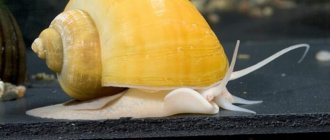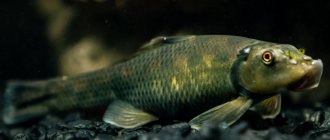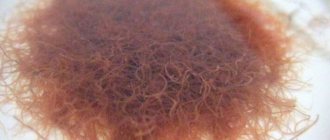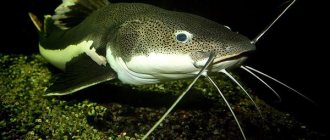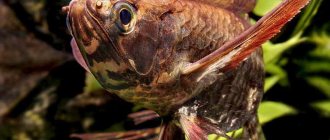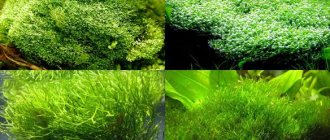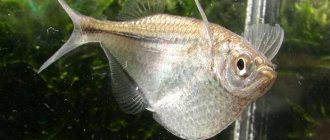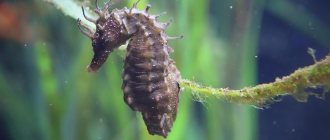- Wild animals
- >>
- Fish
The cockerel fish is an exotic fish popular among aquarists, distinguished by its bright, original appearance. These fish are often called fighting fish. Many people consider these fish to be too picky in terms of care, but all this is compensated by their original appearance and extraordinary character.
Description of sea rooster
The gurnard has a conical long body covered with scales with jagged edges. The head is well protected by a bone shell, on which there are small spines. At the tip of the snout there is a pair of protruding bony plates, on which there are 3-4 spines on each side. There are no transverse stripes on the body.
Trigla (sea cock) has 2 dorsal fins with different numbers of spines and rays. The back is covered by 27 small bone plates. The pectoral fins are very beautiful - they are purple on the outside and blue-green on the inside. They are quite big. Six movable processes extend from the fins, which serve as a kind of “legs” for the fish. The anal fin has almost 20 soft rays.
The gurnard, a fish whose photo can be seen in this article, can have several colors. In the Atlantic Ocean, trigla is usually gray in color, sometimes with a brown or reddish tint. Yellow-white spots are “scattered” throughout the body. There is a black spot on the first dorsal fin.
In the Mediterranean Sea, the guinea pig is red or has a brown tint. There is a dark spot on the dorsal fin. The fish in both reservoirs differ in length. In the Atlantic Ocean, trigla reaches an average of 50 centimeters (in rare cases, up to 90 cm), and in the Mediterranean Sea - up to 30.
Compatibility of cockerels with other fish
Siamese bettas are cocky and aggressive and do not get along with small fish or those with large fins, other bettas or snails, which they eat.
Compatibility chart for males:
| They live together: | Sometimes they fight: | You cannot room together: |
| ● with a swordtail; platylia; thorns; ● zebrafish; ● speckled catfish; ● with gourami; ● mollies; ● iris; ● tetras; ● cardinals; ● harlequins. Males fight more often, females are calm, although sometimes they have problems too. | ● with barbs; ● scalars; ● neon; ● minors; ● with guppy fish; ● labeo; ● lalius; ● ctenobrycon; ● macrognathus. | ● acara; ● a parrot; ● lineatus; ● astronotus; ● goldfish; ● piranhas; ● cichlids. |
Areola and habitat of the gurnard
The most common habitat of the gurnard is:
- Indian and Atlantic oceans.
- Northern, Azov, Marmara, Mediterranean, Black Sea and the western part of the Baltic.
- Strait of the English Channel.
Sea rooster is a bottom-dwelling sea fish. Prefers muddy or sandy bottom. It mainly lives at depths from 10 to 200 meters. In the warm season, triglu can be found near the banks or in river beds.
Variety of colors of cockerels
We should also talk about the variations of color combinations that are found in cockerels. According to color, fighting fish are divided into: single-color, multi-color and two-color. This is a general division. If we consider the species in more detail, we can find a wide variety of different representatives with individual characteristics and rare colors.
Red Royal
The royal cockerel has a rich red color of scales. The betta's color is maintained by the carotenoids it consumes from its food. The Red Royal Rooster is a fish with a complex character. He is distinguished by a tough temper and particular cruelty when defending his personal territory.
Black
He has a calm and quiet character. They have a black body with an unusual gradation in dark blue shades. The caudal fin has stripes, most often blue or red. This type is quite difficult to obtain in its pure form.
Piebald
Has a head made in light colors. From the light silver head further along the body there is an active monochromatic color. Quite often this color comes in combination with marble or “butterfly”.
Emerald with green body
It is a representative of a non-selected species. This species is represented by individuals with a neat, elongated body. It has a long fin at the anus and a short one on the back. The main shade is olive or green. The scales have shiny inclusions of a rich blue hue. It has a red ventral fin edged with a white stripe. The colors of the remaining fins combine several shades. A very valuable natural representative of the breed.
Blue with veil long fins
The main color of the species is active blue. Has a darker head. The pelvic fins and tail in the middle are deep red, and the edges are blue. A very graceful fish.
Cambodian
Cambodian-colored cockerels most often have a light-colored body. Sometimes it seems like there is no pigment. The fins of this individual are colored in bright shades of red or green. An amazing contrast is created, which distinguishes this fish favorably from some less noticeable relatives.
Marble
Marbled cockerels are carriers of an amazing gene mutation, due to which their unusual color appears. They are valuable representatives of betta. Spots of green and blue shades are randomly located on the silver body and fins. Throughout the life of the fish, the spots can change their color and shape. Amazingly beautiful view.
Draconian
The dragon-colored individual has an amazing, multi-layered color. The main color of the body and fins is red. The large scales on the body of the cockerel have a light silver, and sometimes copper color. The fish shimmers very beautifully in the water, acquiring a metallic sheen. There are two separate types of this species, represented by the gold and silver dragon.
Multicolor
It is distinguished by a large number of colors present in the body color. Different colors form patterns, randomly located on the fins and body.
Mask
They have a monochromatic body color. The head of the cockerels is slightly darker than the rest of the body. The tail and tips of the fins may have a dark or light edging. The main body color of the fish is most often represented by blue, turquoise and copper shades.
Butterfly
In cockerels with this type of coloring, the body acquires a monochromatic shade, affecting the fin area, and then abruptly breaks off, making a transition to white, silver or transparent color.
It is believed that the fish can recognize its owner. They happily swim closer to the walls of the aquarium when a person they know comes closer.
What does trigla eat and how does it hunt?
The sea rooster's diet consists of shellfish, shrimp, small fish and crabs. But their favorite prey is red mullet. Trigla lies in wait for this fish, hiding in the algae bordering the open bottom. When a red mullet appears, the gurnard pushes off the bottom with its “legs” and overtakes its prey in one swift leap.
Trigla eats several times a day. But for adult fish, it is enough to eat once a week. Triggles hunt mainly at a depth of up to 30 meters. The processes in the form of “legs” serve not only for movement along the bottom. These are also external taste organs. When the trigla feels for prey in the bottom, it makes a lightning-fast throw. Due to their quick reaction, these fish are considered excellent hunters. Having had enough, the fish rests in the algae thickets, and in the evenings it floats to the surface to bask in the warm water.
Maintenance and care
For beginner aquarists, a suitable option is caring for a betta fish. The advantages of keeping a beta: endurance, the ability to be kept in a small, 3-liter aquarium, and optional aeration. The disadvantages include taking into account the compatibility of the betta and the conflicting nature of the fish.
Aquarium
If there is only one male, you should choose an aquarium for a betta with a volume of 5-10 liters, preferably a rectangular shape. When adding a female, an additional 3-4 liters will be required, that is, this is the norm for each individual betty. A breathable lid or mesh is installed on top to prevent fish from jumping out and allow fresh air to enter.
It is allowed to keep 2 male bettas together if the volume of the aquarium is at least 50 liters and there is a plastic partition with holes in the middle. It is not recommended to purchase a round container, because it is difficult to install equipment and maintain it. Only if you purchase a branded product where the equipment is already built-in.
Water
Cockerels are comfortable at a temperature of 25-28 degrees. If it gets colder, your betta fish will become infected with parasites and get an infection. Therefore, when changing the water, you need to make sure that there is no difference. In a small container, it is recommended to change the water weekly. In a large one - monthly or every 2 weeks, clearing the bottom of food debris. In addition, 25% of the water needs to be constantly changed.
Take bottled or tap water for fish after settling. When filling the container, do not pour it flush with the edges so that the cockerel does not jump out.
When preparing water, you need to check the content of nitrates and phosphates. This is done with inexpensive drop tests. Special bacterial preparations and conditioners will help restore water balance.
Filter and aerator
Cockerels require atmospheric air to breathe, so it is not necessary to aerate the water as well as filter it, although it is worth installing equipment with a minimum flow. The filter promotes uniform heating of water and mechanically purifies the water, maintaining transparency and safety for fish.
Soil and decor
In an aquarium for a betta fish, the bottom is made of river sand, smooth pebbles or purchased colored soil, previously calcined or washed with hot water. The layer is poured no thicker than 3 cm and, preferably, dark in color, so that the multi-colored betta fish look more impressive.
Decorations, driftwood, stones and caves should be chosen with smooth edges and without sharp corners, otherwise the fish will cling to their delicate fins and injure them.
Plants
The aquarium can be decorated with artificial (silk), but preferably live plants in pots, occupying a third of the capacity:
- vallisneria;
- arrowhead;
- anubis;
- hornwort;
- salvinia;
- Cryptocoryne.
Care requires timely thinning and removal of rotten leaves. For fish, these are places for shelter, spawning and the construction of foam nests.
Light
Bettas do not require strong lighting, but light makes the color of the fish brighter and is also necessary for living plants. Therefore, for the aquarium they choose a bright place not in direct sunlight or equip it with special lamps.
Feeding
Betta fish eat natural frozen food and do not refuse dry food made from aquatic insects, their larvae and zooplankton with algae. Experienced aquarists advise not to mix food when feeding fish, but to alternate it. The cockerel is fed 2-3 times a day; at one feeding, as much is given as is eaten in 3-5 minutes. The remains must be removed, and the cockerels are given a fasting day one day a week.
Features of the gurnard
In addition to flying over water, gurnards have the rare ability to “talk.” Triggles often make loud sounds that are clearly audible over water. These fish are capable of grunting, grumbling, purring and snoring. The sounds are so loud that during the Great Patriotic War they drowned out the noise of enemy boats, making it difficult to find out their exact location.
How to distinguish a female from a male
From the outside, this task may seem difficult and impossible. But it is worth noting that rooster individuals have clear gender differences, which clearly manifest themselves when the fish reach two months of age. By what main features can they be distinguished?
The male is much larger than the female, has a more pronounced, bright color and long fins. The female, in turn, has a rounded shape, this is especially noticeable in the abdominal area. In this zone there is an ovipositor, which can be seen on the body of the fish if you find a small white dot on the abdomen. Finding this spot will allow you to easily distinguish the fish. The fin of female bettas, located in the same area, is wider and smoother.
The behavior of the sexes is also different. To learn to distinguish the sex of fish, observe their behavior. Females have a low level of aggression. They get along better together and exist in the same aquarium with other species of fish without conflicts. Males tend to show hostility when fighting for a female or territory.
We figured out the basic rules of care and characteristics of cockerels.
Can a guinea pig fly?
Sea roosters can fly over water up to 20 meters. Jumping forcefully out of the water, the trigla flies over the surface for almost 3 seconds. At this time, her fins spread out like wings. Then the fish plunges into the water with great noise, creating a fountain of splashes. Flight speed can reach 40 km/h. Sea roosters fly mainly after a storm, in the evenings, far from the coast. It is at this time that a lot of small fish gather on the surface of the water, which the trigla hunts for.
Diseases
The betta is a hardy aquarium fish. How long does a rooster fish live in an aquarium? In a favorable environment, cockerels can live for about three years.
Why might a betta change behavior and become less active?
The health and general condition of a betta is most influenced by the cleanliness of the aquarium and quality nutrition. Let's look at the main diseases that aquarium roosters are most often exposed to.
Costiosis
Occurs due to the entry of the flagellate parasite into the aquarium. This most often occurs as a result of the use of unprocessed live food.
A large gray spot appears on the body of the betta, from which thick mucus is secreted. The fish becomes sedentary and passive. It can hide in shelters and hide from relatives. Without proper treatment, the fish dies quite quickly.
What should be done in such a situation?
This disease is curable if an infected individual is detected in time, transplanted and treatment is started. It includes the use of the drug furazalidone. During the quarantine period, it is necessary to change the water daily, care for the sick individual and carefully monitor the condition of the entire population. Duration of treatment is one to two weeks.
Fin rot
Fin rot is a common disease among aquarium fish. The cause of fin rot lies in a pathogenic bacterium. Its entry into the aquarium may be due to the lack of high-quality cleaning of the aquarium, the use of contaminated food, or the introduction of fish that were previously infected.
In the early stages, the disease can be detected by paying attention to the fins. In affected individuals they lose their color. Gradually, the process of erosion begins, turning into active rotting and destruction of the fin.
For treatment, salt baths and streptocide are used. The entire aquarium is disinfected, water, plants, soil and decorative parts are replaced.
Ichthyophthiriasis
The disease appears as a result of an attack by equiciliated ciliates, which enter the aquarium when using infected live food or when adding new fish.
Symptoms of the disease can be noticed by seeing white spots on the cockerel's head. Gradually they cover the entire body of the individual. Gradually, the fish loses strength, loses its appetite, and its behavior changes.
It is necessary to treat the fish using salt baths and special preparations bicillin 5, anti-steam.
Dropsy
Occurs as a result of infection, improper care and feeding of fish.
In infected cockerels, the following symptoms can be noticed: severe weakness, changes in scales, redness of the fins and abdomen. You will notice that the fish becomes very bloated, it becomes lethargic and inactive.
It is worth fighting the disease with the help of white streptocide, a solution of potassium permanganate and bicillin 5.
Why does it lie at the bottom?
A decrease in overall activity and the presence of a betta at the bottom of the aquarium is an alarming signal. In this situation, it is worth paying attention to the factors that could provoke such behavior of the individual.
One of the reasons may be stress caused by environmental changes, species conflicts or other external factors. Observe the behavior of the fish. If she lies on the bottom for a long time and does not show the same activity, then there are problems associated with her physical well-being.
This condition can be caused by a sharp decrease in water temperature or poisoning by toxic substances. Monitor the temperature and composition of the water used to keep the fish. Pay attention to the operation of the filter.
A betta aquarium fish can sink to the bottom as a result of one of the listed diseases. If all necessary measures are not taken in time, the fish may die. Your main task is to determine the reasons for the betta’s poor health and immediately begin to eliminate them. When you feel unwell, you need to take special care of your sick fish.
Sea rooster breeding
Sea roosters begin spawning in June and continue until the end of August. Depending on the habitat, this period can be from January to September. For spawning, fish choose reservoirs with a sandy bottom. Females are able to spawn four times throughout the summer. An individual weighing 2 kilograms lays almost 14 thousand eggs. Then maturation begins, and after 7 days the fry appear. At the age of two weeks, young triggles look very similar to adult fish.
Despite the large number of eggs that females lay, there are fewer and fewer guinea pigs. The main factors influencing the population decline are the deterioration of the ecological situation and the activity of fishermen. Sea cockerels are quite tasty, and many gourmets are willing to pay big money for trigla delicacies. Demand stimulates supply - in some places poachers organize a targeted hunt for this fish.
Social structure and reproduction
Photo: Black Sea rooster fish
The fish have a rather peculiar disposition; they have a hard time making contact with other inhabitants of the reservoir, so they prefer not to contact representatives of other species. Instead, roosters lead largely solitary lives, rarely associating with members of their own species.
Cockerels in nature begin to reproduce at about 5-6 months, when they become sexually mature. If we talk about breeding at home, then special conditions will need to be created for spawning, since the fish are very picky in this matter.
To reproduce, fish need the following conditions:
- warm water;
- a secluded place to create a nest;
- twilight.
The fish carefully choose a place for spawning, preferring waters with a temperature of about 30 degrees with poor lighting. Thickets of underwater plants and burrows are ideal for equipping a kind of nest. First, the male begins to build a kind of nest: air bubbles connected by his saliva.
After this, he begins to approach the female, gradually “hugging” her and squeezing out several eggs, which he carries to the nest and returns for the next ones. When the job is done, the female swims away, but the male remains to guard his nest. By the way, he will take care of the babies for some time after birth.
Interesting fact: The male is such a caring father that he can drive the female away from the nest so zealously that he can even kill her.
After about 1.5 days, the fry will hatch, and after another day the protective bubble will finally burst and they will be able to start living on their own. But with marine species things are a little different. They become fully sexually mature around 4 years of age. Until this time, although they do not live with their parents, they do not take part in spawning and life activities in general as much as adults.
At one time, an adult female lays approximately 300 thousand small eggs. The diameter of each is approximately 1.3-1.6 mm (including the fat drop). Sea roosters go to spawn in the summer. The eggs ripen on average for about 1 week, after which fry hatch from them.
Interesting fact: Even when they are very small, guinea fry are completely similar in appearance to adults.
How to cook sea rooster?
Sea rooster meat is white, dense, contains almost no bones and is similar to steamed chicken. In French cuisine, this fish is a mandatory ingredient for Marseille bouillabaisse soup. Sea rooster meat can be added to a variety of salads. It goes well with cheese, herbs and vegetables.
You can bake a sea rooster in several ways: in parchment, with apples and spinach. Or you can simply fry the fish with mushrooms and onions. Trigla is served to the table as a hot dish. Sea rooster meat can be baked in pots with potatoes, mozzarella and tomatoes, or filleted with a cheese crust. Trigla cooked whole is very tasty. Before baking, it is rubbed with garlic, pepper, salt and olive oil.
Population and species status
Photo: Red rooster fish
Since the habitat of the rooster fish is far from limited to one geographical area, it is extremely difficult to count them. In addition, a large number of fish are in private collections or were recently bred. That is why it is impossible to say exactly how many representatives of the species there are in nature today.
It can be noted that in natural conditions there are much more sea roosters living. They are much more protected and adapted to life, while Siamese bettas are almost completely vulnerable to external threats.
But this applies exclusively to the life of species in natural conditions. If we talk about assessing the population as a whole, then there will be much more cockerels, because a huge number of representatives of various species live in private aquariums.
Despite such popularity and artificial breeding of representatives, the rooster fish is a species that requires special protection. The reasons are directly related to human encroachment on fish.
It is no secret that marine species of rooster fish have very tasty meat, similar to chicken. It is because of this that these species have become popular fisheries targets. Fishermen are not deterred by the rapidly declining number of fish, because the main thing is to catch the delicacy.
Sea rooster: stuffed fish recipe
For this dish you will need 300 grams of trigla, a small head of garlic, a glass of mayonnaise, 100 grams of vegetable oil, pepper and salt. First, several cuts are made across the back of the fish, into which garlic is inserted into slices. Then the sea rooster needs to be rubbed with salt and pepper. Vegetable oil is poured onto a baking sheet. The fish must be sprinkled with flour on one side only - and placed on a baking sheet. Then pour in mayonnaise and cook in the oven over medium heat for half an hour.
Fish is in great demand among Italian and French gourmets. In these countries, there are even several traditional dishes that include gurnard. The fish is really very tasty. We recommend that all tourists visiting Italy and France try it. You can taste the gurnard in every restaurant specializing in seafood cuisine.
Benefits and harms
Sea rooster has no harmful properties; the only unpleasant thing may be individual intolerance and allergy to fish. But fish has many beneficial properties, including the following:
- Rooster dishes are considered dietary because they contain easily digestible protein and harmless fat.
- Fish contains a large amount of vitamins A and E, as well as minerals.
- Potassium, which is part of the composition, normalizes the functioning of the cardiovascular system, preventing the risk of diseases.
- The fillet does not contain small bones, so it can be eaten by children.
- The composition also contains Omega-3 fatty acids, which normalize metabolism in the body.
Caring for fry
Betta fry grow rapidly and do not require special care. In the first few days, it is recommended to feed babies with brine shrimp crumbs or crushed yolk. In the second week, you can add special food for fry or crushed tubifex to the diet. During the period when the fry appear, it is necessary to change three quarters of the total amount of water every day. By the third week, conflicts may arise between the growing individuals. To prevent such situations, it is necessary to remove large individuals from smaller and weaker ones.
In this article, we examined in detail the characteristics of the character and appearance of the betta. The once wild fish, the betta, perfectly adapted to the conditions of the aquarium and was able to become a true friend for humans.
Choose your cockerel responsibly and carefully. Take a closer look at the behavior of the fish during the purchase. Watch how she interacts with other inhabitants of the aquarium. Choose with your heart and mind.



